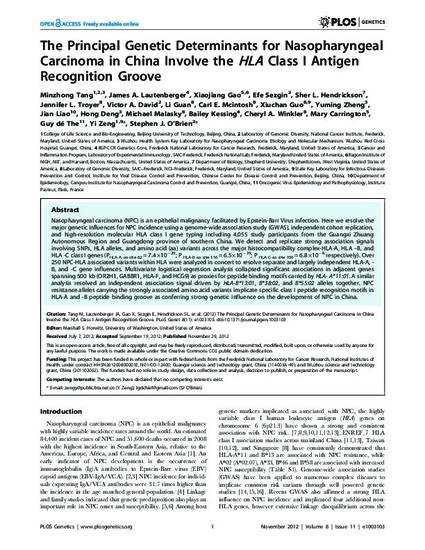
Nasopharyngeal carcinoma (NPC) is an epithelial malignancy facilitated by Epstein-Barr Virus infection. Here we resolve the major genetic influences for NPC incidence using a genome-wide association study (GWAS), independent cohort replication, and high-resolution molecular HLA class I gene typing including 4,055 study participants from the Guangxi Zhuang Autonomous Region and Guangdong province of southern China. We detect and replicate strong association signals involving SNPs, HLA alleles, and amino acid (aa) variants across the major histocompatibility complex-HLA-A, HLA –B, and HLA -C class I genes (PHLA-A-aa-site-62 = 7.4×10−29; P HLA-B-aa-site-116 = 6.5×10−19; P HLA-C-aa-site-156 = 6.8×10−8 respectively). Over 250 NPC-HLA associated variants within HLA were analyzed in concert to resolve separate and largely independent HLA-A, -B, and -C gene influences. Multivariate logistical regression analysis collapsed significant associations in adjacent genes spanning 500 kb (OR2H1, GABBR1, HLA-F, and HCG9) as proxies for peptide binding motifs carried by HLA- A*11:01. A similar analysis resolved an independent association signal driven by HLA-B*13:01, B*38:02, and B*55:02 alleles together. NPC resistance alleles carrying the strongly associated amino acid variants implicate specific class I peptide recognition motifs in HLA-A and -B peptide binding groove as conferring strong genetic influence on the development of NPC in China.
Available at: http://works.bepress.com/stephen-obrien/634/

This is an open-access article, free of all copyright, and may be freely reproduced, distributed, transmitted, modified, built upon, or otherwise used by anyone for any lawful purpose. The work is made available under the Creative Commons CC0 public domain dedication.